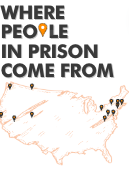Search Results
Your search returned 0 categories and 31 Links.
Pages: 1 2 [>>]
-
Safe At Home: Improving Maryland's Parole Release Decision Making Justice Policy Institute, May, 2023“In Maryland, [parole] grant rates decline sharply beginning at 40 years of age.”
-
COVID-19 amplified racial disparities in the US criminal legal system Brennan Klein, C. Brandon Ogbunugafor, Benjamin J. Schafer et al, April, 2023“States with fewer short-term prison sentences (Maine, Maryland, Missouri, Oregon and Wyoming) did not show the same racial disparity we found nationally.”
-
 Where people in prison come from: The geography of mass incarceration in Maryland Justice Policy Institute and Prison Policy Initiative, June, 2022“A number of less populous areas, including Wicomico, Dorchester, and Somerset counties on the Eastern Shore, rank in the top fifth of Maryland counties when it comes to prison incarceration rates.”
Where people in prison come from: The geography of mass incarceration in Maryland Justice Policy Institute and Prison Policy Initiative, June, 2022“A number of less populous areas, including Wicomico, Dorchester, and Somerset counties on the Eastern Shore, rank in the top fifth of Maryland counties when it comes to prison incarceration rates.”
-
 Since you asked: What information is available about COVID-19 and vaccinations in prison now? Prison Policy Initiative, December, 2021“Only two states -- Maryland and South Carolina -- are publishing the number of incarcerated people who have refused the vaccine, while no prison systems are publishing the number of staff who have refused a vaccine.”
Since you asked: What information is available about COVID-19 and vaccinations in prison now? Prison Policy Initiative, December, 2021“Only two states -- Maryland and South Carolina -- are publishing the number of incarcerated people who have refused the vaccine, while no prison systems are publishing the number of staff who have refused a vaccine.”
-
'I Refuse to Let Them Kill Me': Food, Violence, and the Maryland Correctional Food System The Maryland Food & Prison Abolition Project, September, 2021“Food in prison serves three fundamental functions: as an everyday mechanism of control, dehumanization, and punishment; as a site of exploitation and profit for private food service corporations; and as a form of violence and premature death.”(This report is divided into six parts, all of which are available at this link.)
-
Violence, Hunger, and Premature Death: How Prison Food in Maryland Became Even Worse During Covid-19 The Maryland Food & Prison Abolition Project, August, 2021“As atrocious as the correctional food systems were prior to 2020, however, the Covid-19 pandemic drastically exacerbated the crisis of prison food prison.”
-
Chasing Justice: Addressing Police Violence and Corruption in Maryland ACLU of Maryland, January, 2021“91% of officers' use of force was targeted toward Black residents.”
-
The Intersection of Race and Algorithmic Tools in the Criminal Legal System Vincent M. Southerland, October, 2020“[Algorithmic] tools, as currently designed and deployed in the current legal framework fail to correct or upend the racial inequity that pervades the criminal legal system.”
-
Rethinking Approaches to Over Incarceration of Black Young Adults in Maryland Justice Policy Institute, November, 2019“Nearly eight in 10 people who were sentenced as emerging adults and have served 10 or more years in a Maryland prison are black. This is the highest rate of any state in the country.”
-
Advancing Bail Reform in Maryland: Progress and Possibilities Baltimore City and Prince George's County Branches of the NAACP, February, 2018“This report argues that Maryland policymakers should continue to strengthening the alternatives to bail and pretrial detention.”
-
The impact of residential change and housing stability on recidivism: pilot results from the Maryland Opportunities through Vouchers Experiment (MOVE) David S. Kirk, Geoffrey C. Barnes, Jordan M. Hyatt, and Brook W. Kearley, December, 2017“Rearrest was lower among the treatment group of movers than the non-movers, and was also lower for non-movers who received free housing versus non-movers who did not receive housing.”
-
Parole Perspectives in Maryland: A Survey of People Who Returned to Prison from Parole and Community Justice Policy Institute, May, 2015“A new analysis from the Justice Policy Institute (JPI) shows the connection between efforts to reduce prison populations, connect people to work, and address the challenges of Baltimore's distressed communities”
-
 The Right Investment?: Corrections Spending in Baltimore City Justice Policy Institute; Prison Policy Initiative, February, 2015“Maryland taxpayers spend $288 million a year to incarcerate people from Baltimore City.”
The Right Investment?: Corrections Spending in Baltimore City Justice Policy Institute; Prison Policy Initiative, February, 2015“Maryland taxpayers spend $288 million a year to incarcerate people from Baltimore City.”
-
The Effect of Collateral Consequence Laws on State Rates of Returns to Prison University of Maryland, Department of Criminology and Criminal Justice, July, 2014“Surprisingly, these analyses give some indication that collateral consequences may be related to lower rates of returns to prison for technical violations, however future research is needed to confirm this relationship.”
-
When Treatment is Punishment The Effects of Maryland's Incompetency to Stand Trial Policies and Practices Justice Policy Institute, October, 2011“Too many people found not competent to stand trial are unnecessarily locked in a secure setting for treatment and, on average, confined for longer periods than research demonstrates is clinically reasonable.”
-
 Importing Constituents Incarcerated People and Political Clout in Maryland Prison Policy Initiative, March, 2010“In Somerset County, a large prison is 64% of the 1st Commission District, giving each resident in that district 2.7 times as much influence as residents in other districts.”
Importing Constituents Incarcerated People and Political Clout in Maryland Prison Policy Initiative, March, 2010“In Somerset County, a large prison is 64% of the 1st Commission District, giving each resident in that district 2.7 times as much influence as residents in other districts.”
-
The Release Valve: Parole in Maryland Justice Policy Institute, March, 2009“[I]n 2007 [Maryland] spent approximately $1,422 per person on parole or probation, and $33,310 per person incarcerated.”
-
Judging Maryland Baltimore Judges on Effective Solutions to Working with Substance Abusers in the Criminal Justice System Justice Policy Institute, March, 2009“Judges recommend an increase in or expansion of residential care facilities and a more holistic approach to helping substance abusers caught up in the criminal justice system.”
-
A Report on the Collateral Consequences of Criminal Convictions in Maryland University of Maryland School of Law, 2009“Despite the lasting and sometimes permanent effects that collateral consequences impose upon ex-offenders and their families, no formal mechanism exists for defendants in Maryland, or any other state, to be informed of these consequences.”
-
Impact and Cost-Benefit Analysis of the Maryland Reentry Partnership Initiative Urban Institute, February, 2007“This study evaluates the impact of the Maryland Reentry Partnership Initiative (REP) on crime in Baltimore between 2001 and 2005.”
-
Progress and Challenges: An analysis of drug treatment and imprisonment in Maryland from 2000 to 2005 Justice Policy Institute, September, 2006“Crime trends since 2000 appear to support the argument that treatment does more than imprisonment to reduce crime.”
-
Tipping Point: Maryland's Overuse of incarceration and the impact on Public Safety Justice Policy Institute, March, 2005
-
Race and Incarceration in Maryland Justice Policy Institute, October, 2003
-
Maryland: An Assessment of Access to Counsel and Quality of Representation in Delinquency Proceedings American Bar Association Juvenile Justice Center, October, 2003
-
A Portrait of Prisoner Reentry in Maryland Urban Institute, March, 2003
Pages: 1 2 [>>]
Pages Updated On: 27-Jul-2024 - 02:09:54
Links Engine Powered By: Gossamer Threads Inc.
 Where people in prison come from: The geography of mass incarceration in Maryland Justice Policy Institute and Prison Policy Initiative, June, 2022
Where people in prison come from: The geography of mass incarceration in Maryland Justice Policy Institute and Prison Policy Initiative, June, 2022 Since you asked: What information is available about COVID-19 and vaccinations in prison now? Prison Policy Initiative, December, 2021
Since you asked: What information is available about COVID-19 and vaccinations in prison now? Prison Policy Initiative, December, 2021 The Right Investment?: Corrections Spending in Baltimore City Justice Policy Institute; Prison Policy Initiative, February, 2015
The Right Investment?: Corrections Spending in Baltimore City Justice Policy Institute; Prison Policy Initiative, February, 2015 Importing Constituents Incarcerated People and Political Clout in Maryland Prison Policy Initiative, March, 2010
Importing Constituents Incarcerated People and Political Clout in Maryland Prison Policy Initiative, March, 2010